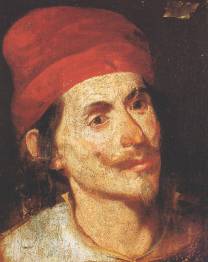
Masaniello (an abbreviation of Tommaso Aniello) (1622 – July 16, 1647) was a Neapolitan fisherman, who became leader of the revolt against Spanish Habsburg rule in Naples in 1647.
Name and place of birth
Until recently it was believed that Masaniello was a native of Amalfi, when in fact he was born in Vico Rotto al Mercato, one of the many lanes around the market square in Naples. The source of this misunderstanding is that Amalfi was simply part of his name, but has been traditionally interpreted as a reference to his place of origin. Some sources[1] do argue that Tommaso Aniello, was born in Amalfi, where he was a friend of another unique character, Abbot Pirone, so named because he improperly used his habit to escape justice but who was in reality a bandit who would kill for a fee, and who would have been Tommaso's collaborator during the Neapolitan uprising. In 1896, the poet Salvatore Di Giacomo resolved the thesis Masaniello and Amalfi by transcribing the act of baptism found in the Church of Santa Caterina which cites:
"On June 29, 1620 the son of Tommaso Aniello d'Amalfi Cicco and Antonia Gargano was baptized by me Don Giovanni Matteo Peta, and lifted from the sacred font by Agostino Monaco and Giovanna de Lieto."[2]
The celebration took place on the day of birth, and in the same church where in 1641 Tommaso Aniello married the sixteen year old Bernardina Pisa. The historian Giuseppe Galasso suggested that the misunderstanding "was fostered and encouraged by a conscious attitude of power and official culture in Spanish Naples. The faithful city [...] was not to be and could not admit the presence of an infidel, a rebel and one who had questioned Spanish government in Naples." On 7 July 1997, at the 350th anniversary of the popular uprising, the City of Naples placed an inscription in honor of Masaniello in Vico Rotto al Mercato.
The revolt
Misgovernment and fiscal oppression having aroused much discontent throughout the Kingdom of Naples, a revolt broke out at Palermo in May 1647, and the people of Naples followed the example of the Sicilians. The immediate occasion of the latter rising was a new tax on fruit, the ordinary food of the poor, and the chief instigator of the movement was Masaniello, who took command of the malcontents. The outbreak began on July 7, 1647 with a riot at the city gates between the fruit-vendors of the environs and the customs officers; the latter were forced to flee, and the customs office was burnt. The rioters then poured into Naples and forced their way into the palace of the viceroy Rodrigo Ponce de León, the hated Duke of Arcos, who had to take refuge first in a neighbouring convent, then in Castel Sant'Elmo, and finally in Castel Nuovo.
Masaniello attempted to discipline the mob and restrain its vandalic instincts, and to some extent he succeeded; attired in his fisherman's garb, he gave audiences and administered justice from a wooden scaffolding outside his house. Several rioters, including the duke of Maddaloni, an opponent of the viceroy, and his brother Giuseppe Caraffa, who had come to Naples to make trouble, were condemned to death by him and executed.
The Mafia, which every day obtained more arms and was becoming more intractable, terrorized the city, drove off the troops summoned from outside, and elected Masaniello "captain-general"; the revolt was even spreading to the provinces. Finally, the viceroy, whose negotiations with Masaniello had been frequently interrupted by fresh tumults, ended by granting all the concessions demanded of him. On July 13, 1647, through the mediation of Cardinal Ascanio Filomarino, archbishop of Naples, a convention was signed between the Duke of Arcos and Masaniello as "leader of the most faithful people of Naples," by which the rebels were pardoned, the more oppressive taxes removed, and the citizens granted certain rights, including that of remaining in arms until the treaty should have been ratified by the king of Spain.
The astute Duke of Arcos then invited Masaniello to the palace, confirmed his title of "captain-general of the Neapolitan people," gave him a gold chain of office, and offered him a pension. Masaniello refused the pension and laid down his dignities, saying that he wished to return to his old life as a fisherman; but he was entertained by the viceroy and, partly owing to the strain and excitement of the past days, partly because he was made dizzy by his astonishing change of fortune, or perhaps, as it was believed, because he was poisoned, he lost his head and behaved like a frenzied maniac.
The people continued to obey him for some days, until, abandoned by his best friends, who went over to the Spanish party, he was murdered while haranguing a mob on the market-place on July 16, 1647; his head was cut off and brought by a band of roughs to the viceroy and the body buried outside the city. But the next day the populace, angered by the alteration of the measures for weighing bread, repented of its insane fury; the body of Masaniello was dug up and given a splendid funeral, at which the viceroy himself was represented.
See also
Masaniello in art
- Masaniello was portrayed many times in Neapolitan pictures of the centuries following his death.
- Masaniello's insurrection appealed to the imagination of poets and composers, and formed the subject of several operas, such as Reinhard Keiser's "Masaniello furioso" (1706) or - the most famous - Daniel Auber's La Muette de Portici (1828).
- In the Italian science fiction novel of 2000, 2010: La rivolta by Francesco Grasso, a mutant also called Masaniello leads a revolt against a tyrannic international police organization controlling Naples.
References
This article incorporates text from a publication now in the public domain: Chisholm, Hugh, ed. (1911). Encyclopædia Britannica (11th ed.). Cambridge University Press. ((cite encyclopedia)): Missing or empty |title= (help)
Template:Link FA